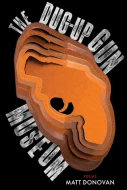 Matt Donovan
Matt Donovan
The Dug-Up Gun Museum
BOA Editions
Reviewer: David E. Poston
In The Dug-Up Gun Museum, Matt Donovan leads us on a brilliantly conceived, meticulously researched journey into the heart of America’s gun culture, a journey described with flawless technical skill. From the first poem, we are whisked through one superbly paced narrative after another, rendered alternately in dense blocks of text or long, loose, irregular lines that use indentation to keep our eyes moving down the page. Most lines are enjambed, with an occasional full-stop to let us catch our breath before the next flood of images.
The language of the sacred: prayer, haloes, saints, heaven, a cappella gospel—and the prophetic: handwriting on the wall—is intermixed with images of a violence that is both feared and fetishized. A war game participant’s patch depicts “a cross bookended by two rifles that hovered above the words Waterboarding is how we baptize the terrorists.” When Donovan thinks he is a casualty in a battle simulation at Fort Hood, Texas, his commander resurrects him with a wave of his hands. “You’re alive,… Your soul is back.” In “Yeats Claimed a Poem Should Come Together,” Donovan asks
given what’s for sale in the Battlefield Vegas
gift shop, would it be better to choose
the shotgun shells glued together to form a cross
or that pink hoodie with the word LOVE spelled out
using a Glock, a hand grenade, a switchblade,
& the long dark shape of an AR-15 …
The company that sponsors the Fort Hood exercise also hosts a reenactment of the Battle of Mogadishu in a shut-down Packard plant in Detroit. A visit to the Museum of Connecticut History in “Land of 1000 Dances” describes how the chambers of a Colt slip perfectly into place “like an American vision of heaven.”
The opening poem, “Portrait of America as a Friday the 13th Flashlight Tour of the Winchester Mystery House,” uses first-person plural to enroll the reader and present or present-progressive tense to create immediacy. This is happening in real time, and we are sucked along with the crowd searching for cheap thrills:
… A doorknob rattling. A sound
like pounding, bursts of light. These things happen
all the time. And if in that moment none of us heard
how those tales of the dead echoed not the dead
but stories of our shootings & those who survived
(A nearby bang. Someone gripping a shoulder. The sound
of boots & breathing. Someone else in the room.) would you
blame us? That would entail stepping through aftermath
of a different order, one a far cry from what we paid for.
From that poem, we step into a world where grown-ups play Navy SEAL and shoot paintball guns at pictures of Justin Bieber and Bin Laden duct-taped to buckets.
In “D-Day: Albrightsville, Pennsylvania,” a Normandy invasion reenactment is described in a dazzling flood of detail, ending as “the door of the Utah” drops and everyone whoops as they rush out into combat. In contrast to those adrenaline-fueled games, other poems describe a heart-wrenching reality. In Planet Fitness, a video of Terence Crutcher being shot by police plays during workouts. In the Stony Island Arts Bank in Chicago, one can see the gazebo from the site where Tamir Rice was killed.
We meet an extraordinary array of both iconic and real-life characters. Some are sadly familiar: a surgeon suggesting Sandy Hook autopsy photos be made public, a mother in the basement of Saint Sabina Church pointing out the picture of her slain son, neighbor Pat in “Fake News Bus Stop Prayer” who will never read the poem about him, a principal explaining “Although no one likes this drill … it’s a price for freedom we can’t afford to lose.” Others are less familiar, but they illustrate the tragic complexities that extend beyond the news cycle. “Guy with a Gun” presents a teacher in Newtown, Connecticut who is both traumatized by the Sandy Hook massacre, vilified for speaking the truth about it, and permanently stigmatized by a momentary lapse involving his own firearm.
These characters prod us in both explicit and subtle ways to consider the current state of America. “The Thing with Feathers Isn’t Hope” describes an artist who assembled a 400-pound replica of a pistol to haul across America from Chicago to Sandy Hook (two communities which illustrate the spectrum of gun violence in this county):
But when he stopped for gas the first time,
he knew his art had failed when a man
sprinted across the parking lot to say
Goddamn, that’s one bad ass gun.
Something needed to change.
The title poem describes a real-life place in Cody, Wyoming, displaying the American gun experience, as their slogan puts it, “From Flintlock / to Full Auto, an alliterative phrase that glides through / three centuries of weapons that shaped our country—.”
This country has moved from watching The Good, the Bad, & the Ugly and parading John Wayne beside a thirty-foot Winchester on the Fourth of July to training armed teachers how to distinguish good guys from bad guys in a classroom. This book contrasts the mythology of Lillian Gish in Birth of a Nation embracing her Klansman beau with the reality of twelve-year-old Tamir Rice tossing a snowball moments before the police are called. “Portrait of America as the Hands of Peter Graves in The Night of the Hunter” contrasts a Hollywood world of white picket fences with the world in which Wayne Jones is shot by police for not walking on the sidewalk. In the Hollywood version of America, the police officers wait patiently for the armed fugitive to say a tender goodbye to his son. In real-life America, Wayne Jones is shot twenty-two times by a semi-circle of police officers.
Not since Claudia Rankine’s Citizen has there been a poetry collection this timely, potent, or important. Donovan shows how religion and patriotism, fear and fascination, and the sacred and the profane have been woven together into a uniquely American nightmare. Our culture fetishizes Jack Ruby’s .38 Colt Cobra and the Philadelphia derringer wielded by John Wilkes Booth. We rush to take up arms against imagined enemies, whether on a paintball course or beside a gazebo.
Donovan has no illusions about his audience, how most of the people whom we meet on this journey will never read these poems. Twice in these pages, he refers to “the silence within a poem.” Yet despite his self-deprecating stance, these poems speak much more loudly than plaintive prayers we have all heard all too often. Donovan has earned the right to speak by traveling into the often-surreal corners of American gun culture and having tough, vital conversations. The poem “Solipsism: A Story” provides a glimpse of what happens if we leave our thought-silos. It drops us into a conversation with a gun owner who says
Don’t take this the wrong way, but I’ve been telling folks I met some guy
who doesn’t own a gun, an unarmed dad, & no one can believe it.
We looked at each other for a half-beat, maybe more, & didn’t say
what we were thinking about how each of us had chosen to move through this world,
or how both of us by then had turned into a story about something impossible
glimpsed somewhere we thought we knew. I haven’t spoken to him since.
Just as Citizen prodded some of us to examine our solipsistic blind spots about racism, reading this book may prod us to recognize that none of us are innocent bystanders when it comes to gun violence and that we all need to both speak out and listen.

